The Storm Breaks: Torg Eternity (Part Two)
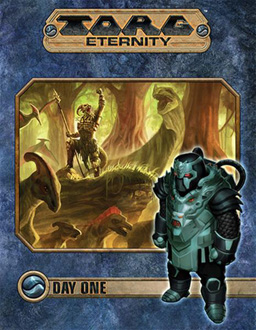 Last Sunday I ran my first session of Torg Eternity, meaning I can now finish my review of the game by discussing how the rules worked in practice (the first part is here, with a description of the basic idea of the mechanics and of the game setting — an Earth invaded by seven different dimensions). Worth noting to start with that I’d been spending time on the message boards for the game, discussing the different realms and how I wanted to play them. Some minor questions I’d had about rule interpretation had been cleared up; more than fair to say I found the boards a useful resource for gamemasters, especially since one of the designers, Deanna Gilbert, is very active in responding to questions and comments.
Last Sunday I ran my first session of Torg Eternity, meaning I can now finish my review of the game by discussing how the rules worked in practice (the first part is here, with a description of the basic idea of the mechanics and of the game setting — an Earth invaded by seven different dimensions). Worth noting to start with that I’d been spending time on the message boards for the game, discussing the different realms and how I wanted to play them. Some minor questions I’d had about rule interpretation had been cleared up; more than fair to say I found the boards a useful resource for gamemasters, especially since one of the designers, Deanna Gilbert, is very active in responding to questions and comments.
Along with the Torg Eternity rulebook, I had two anthologies of short adventures, the Day One collection and the Delphi Missions: Rising Storm collection. The Day One adventures followed pregenerated characters through adventures set on the first day of the invasions. That was useful in giving me a sense of what the opening of the invasions was like, but I didn’t immediately see anything I wanted to adapt to a regular group — each of the Day One stories followed a group of Core Earthers caught up in the invasion of one specific cosm, whereas my players had characters from across the realms. The Delphi Missions adventures ranged from relatively brief scenarios to stories that’d clearly occupy a full session or more of play. Again, though, all the adventures focussed on one cosm. I could see the benefit for an introductory collection of adventures; each showed something of the feel of a given realm. But what always made Torg fascinating to me was the crossing-over of realities.
Both books had some very well-designed scenarios in them. I particularly liked “The Dumas Gambit” in Delphi Missions, which describes a setting in the Cyberpapacy occupied by various factions of street gangs and then introduces the players with an objective that sets the factions against each other. Meanwhile, there’s a moment in the Day One adventures that really gave me a feel for the splatterpunk reality of Tharkold just by describing a certain corpse the characters find. That sort of thing makes both books worth looking at for Torg Eternity gamemasters, I think, moments and descriptions that help establish the feel of the different realities, the kind of stories that get told in them.
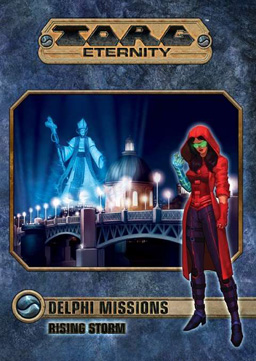 Going into my own game, I was impressed with the game’s character-generation system. The player chooses basic attributes (Dexterity, Mind, and so forth), then a set of skills, and then two perks — access to cool things from their reality, like the ability to cast spells or invoke miracles, special martial-arts moves, or, in the case of Core Earthers, an ability to more easily move from one reality to another. Because each character gets two perks, characters can have more than one cool thing about them. So the three characters in the game were: Christian, a Core Earth academic with some rudimentary psychic gifts and a bit of training with guns from his time in a military college; Gaeira, a witch from the Cyberpapacy whose spellcasting was enhanced by her cyberware; and Pel, an elven bard with some magic-using ability and a knack for rallying others.
Going into my own game, I was impressed with the game’s character-generation system. The player chooses basic attributes (Dexterity, Mind, and so forth), then a set of skills, and then two perks — access to cool things from their reality, like the ability to cast spells or invoke miracles, special martial-arts moves, or, in the case of Core Earthers, an ability to more easily move from one reality to another. Because each character gets two perks, characters can have more than one cool thing about them. So the three characters in the game were: Christian, a Core Earth academic with some rudimentary psychic gifts and a bit of training with guns from his time in a military college; Gaeira, a witch from the Cyberpapacy whose spellcasting was enhanced by her cyberware; and Pel, an elven bard with some magic-using ability and a knack for rallying others.
To give a feel for the gameplay, I’ll describe what happened in the session and how the rules supported the story. I began with one with one player:
Christian entered the catacombs of Paris warily. He’d escaped France after the invasion of the Cyberpapacy; a professor at the Sorbonne, he’d refused to name names to Pope Jean Malraux’s Church Police, and fled. Now based in Germany, he’d worked with the Resistance fighters in Paris to help set up an escape route for other academics fleeing the Church’s crackdown on “freethinkers.” But something had gone wrong for one of his good friends, Carl Sauvé. The Church Police had caught Carl’s Resistance contact, and now Carl was refusing to move unless Christian, someone he trusted, came to get him. More, Carl was claiming he had important information on a USB key about the nature of Malraux’s GodNet …
Background established, I decided to keep going with him:
Christian strode deeper into the catacombs, past walls lined with bones. With Paris virtually under siege, nobody was tending to the catacombs, and he saw derelicts blitzed out of their minds on new designer drugs, heard two men noisily having sex down one of the dark tunnels. He came to where he was to meet Carl, a circular widening of the passage with a half-dozen slumped drunks motionless on the floor. He was early, but as he entered, one of the twitching shapes leaped up and grabbed him: Carl, unshaven, pupils dilated, panicked, on speed.
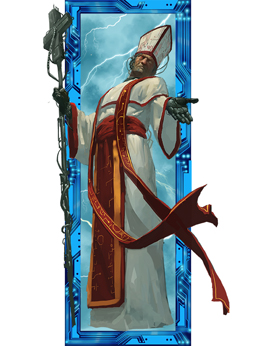 Paris is technically not in the cyberpunk reality of the Cyberpapacy, but I felt it was close enough that the same kind of transgressive genre furniture should help set the scene and build up the tension of the Possibility Wars.
Paris is technically not in the cyberpunk reality of the Cyberpapacy, but I felt it was close enough that the same kind of transgressive genre furniture should help set the scene and build up the tension of the Possibility Wars.
Christian tried to calm him. But then one of the drunks shrieked. Christian happened to be looking in exactly the right spot to see what was happening: bodies were stirring on the shelf-like top of the wall. Christian saw corpses covered in plant growth, vegetation knitting together putrefying flesh, fingers ending in bone claws. They dropped down to the floor, and lumbered forward. Christian retreated down a hallway as the creatures drew near. Then another figure strode into the bone-lined space, a cyberknight with the armour and insignia of Malreaux’s military order of Hospitallers. “Get them!” he cried, pointing to Christian and Carl, and the dead things moved to obey.
I flipped a card to start round play; I wanted to introduce the players to the idea of a test, to how the die rolls and bonus chart worked. Christian’s player rolled well enough on his Mind check to spot the zombie-creatures, gospog, as they began to stir. That let him move on his action as the knight entered the scene. Note that players also have a hand of Destiny cards, each of which gives them certain mechanical benefits or effects, and each round can move one card from their hand into a pool from which they can play the cards as they like.
From this point, I moved to another character, flashing back …
Gaeira was a witch from Magna Verita, the home dimension of Jean Malraux and the Cyberchurch. Tired of living under his oppressive dictatorship, she’d decided to slip across the Maelstrom Bridge to Earth with the help of her coven. There, she’d been surprised to see how a world well behind her own technologically could be ahead of it socially — more open, more accepting. She’d drifted to Paris at about the same time Christian was leaving it, where she was stunned at how overtly she could practice her religion, how she could even find bookstores catering to the occult. (The books didn’t seem to do much, true, but still.) She made contact with the Resistance, helping them in some of their missions and casting minor spells. And so it went until one day she got a call on her primitve Earth smartphone from her Resistance contact: the Resistance had learned that a cyberknight had interecepted some information and was preparing an ambush for a crucial agent in the catacombs. This was happening now, and Gaeira was the only one near enough to get there …
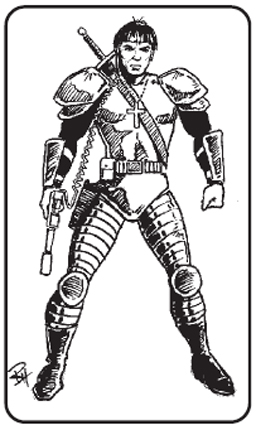 … and then catching up with Christian’s scene.
… and then catching up with Christian’s scene.
Gaeira cast a spell to cloak herself in magical armour as she ran to the location in the catacombs she’d been given. She heard a man cry out: “Get them!” She cast another spell, and began moving with an unnatural magical haste.
Ahead, Christian decided he had a few seconds before the lumbering plant-zombie-creatures reached him. Carl was running down the tunnel behind him, but he aimed at the knight carefully, drawing on what he’d learned at the military academy he’d once attended …
Then Gaeira reached the fray, shouting behind her: “Everyone! They’re here!” The cyberknight spun, confused. She shot him with a burst of three rounds from her Storm Surge shotgun.
After seeing the zombies, Christian’s player took a round to aim, gaining a bonus to hit and activating his Sniper perk, which would give him bonus damage. The knight’s action was to move closer, draw his gun, and direct the gospog (technically he could have fired the gun, but drawing and directing was pushing the amount of simple actions one can do, and I decided he wanted Carl alive so held off on blasting away). I flipped a new initiative card; the game determines initiative with the Drama deck, each card of which establishes initiative in a round, establishes conditions (whether one side or another is fatigued, for example), and lists approved actions. This card listed trick as an approved action, so Gaeira’s player decided to try to trick the knight, succeeded, and left him Vulnerable, meaning attacks against him were at a bonus until his next action. The player got a card for successfully performing an approved action. And since she’d cast haste the round before, she had an extra action, and shot the knight. Christian’s player then fired:
Christian squeezed the trigger. It was a good shot and should have dealt the knight a crippling blow. But — something happened, the world went a different way, and the bullet creased his skull without droppng him.
The knight used a Possibility, a hero point, to soak damage — to partially undo the effect of Christian’s shot.
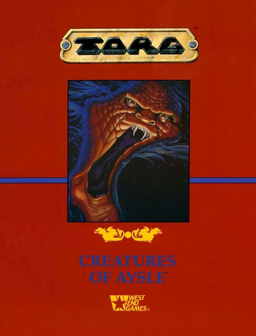 Maddened, the knight drew his sword, strode to Gaeira, swung — and Christian yelled “duck!” to the stranger who’d come to help him. She did, and the knight missed.
Maddened, the knight drew his sword, strode to Gaeira, swung — and Christian yelled “duck!” to the stranger who’d come to help him. She did, and the knight missed.
Christian’s player traded Gaeira’s player a card called Adrenalin, which let her boost her Dexterity attribute just enough that the knight’s attack missed. It’s nice when you can come up with an in-story mechanism, however slender, to represent card trading.
But at this point I thought we’d spent enough time with these two characters. I cut away to the third:
Pel was an elven bard who’d come over the bridge from Aysle to Earth. They’d followed a detachment of elves who’d joined the Army of Light directed by the Lady Pella Ardinay, which had cut through the evil things guarding the bridge between realms. Pel had never really been a part of the army; like many of the wild-natured elves, they’d accompanied the army without being truly within it — although many of the more formal humans, with their brief lives and need to force sense and structure upon the world, had not understood that. Now Pel was exploring this world of odd wonders; they had spent most of these past weeks in the great city hight Helsinki, where the high science of Earth worked alongside the old magics of Aysle. They had found themselves a kind of familiar, who they treasured above all things, a wondrously knowledgeable spirit by name Siri, who dwelt in a prism of glass.
On this day Pel was wandering among pine forests well north of the city, where the axioms of Aysle — the ways of the world — had washed away some of those man-built things that were of Earth, and had brought forth new makings that were not new: ruins where there had been no ruins, plinths bare of statues, a crumbling wall of white stone. Pel pleased themself by flitting among the trees as elves do; and then they crested a ridge and saw below an encampment of goblins and Viking men and corpses that walked though overgrown with greenery. It was an army, encamping, preparing for some future descent upon Helsinki. At once Pel drew forth Siri and by her magic captured an image of the camp. Then they set back the way they’d come, hoping that as they’d unwittingly passed the army’s sentries once, they might do so again.
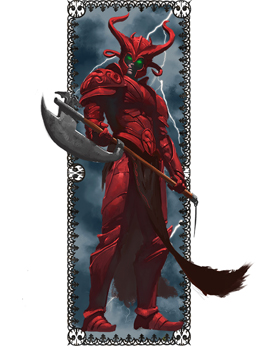 That wasn’t to be; as they went they heard a cry, and six Vikings bellowed to them to halt. Pel took to their heels, as behind them one of the Vikings winded a horn and the rest set out in pursuit. Pel hatched a plan …
That wasn’t to be; as they went they heard a cry, and six Vikings bellowed to them to halt. Pel took to their heels, as behind them one of the Vikings winded a horn and the rest set out in pursuit. Pel hatched a plan …
Pel’s plan involved several steps, allowing me to try out the Dramatic Skill Resolution sub-system of the game. Basically, Pel had to succeed at four separate skill tests; the cards would determine when they could try each one.
First, Pel outran the Vikings, gaining distance. Then, after a moment of confusion in which Pel thought they’d lost their path, they found the right direction and raced out of sight of the Vikings. They made their way to the ruins they’d passed, and cast a spell to disguise themselves as a statue. Finally, standing on a plinth, they struck a pose they hoped would fool the Vikings. A moment later the warriors blundered to the ruins, calling out to each other — “Where’d she go? Where is she?” And they moved on.
We had a brief discussion about how the Vikings would perceive the genderfluid elf. “At this moment,” the player reflected, “being misgendered by the Vikings is not the thing I’m most worried about.” They successfully performed the four steps of the dramatic skill resolution: a Dexterity-based running check to put distance between them and the Vikings, a second running check to get out of the Vikings’ sight as Pel reached the ruins, a magic check to cast a disguise spell to look like a statue, and finally a trick roll (against the Vikings’ Mind score, not terribly high; I might have used persuasion, but trick seemed marginally more appropriate) to successfully act like a statue. With the help of cards and Possibilities, Pel succeeded at all these things, and also along the way succeeded at a roll to avoid a possible complication (when they were briefly confused about the right path).
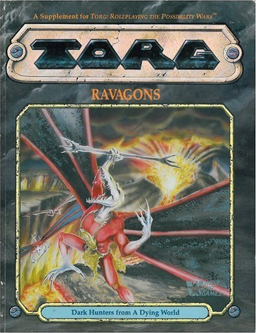 Still, other Vikings could be heard in the forest not too far away. Pel saw a small building among these ruins, and slipped inside, hoping to find a better hiding-spot. Among the flagstones, they saw a marble square with a steel ring — a trapdoor. They opened it to find a long flight of stairs deep into the earth, and descended, closing the trapdoor behind them. They aided their elven darkvision with the light of Siri as they went on down the long flight; by Siri’s timekeeping it was 34 minutes before they reached the bottom of the stairs, and there they heard a battle.
Still, other Vikings could be heard in the forest not too far away. Pel saw a small building among these ruins, and slipped inside, hoping to find a better hiding-spot. Among the flagstones, they saw a marble square with a steel ring — a trapdoor. They opened it to find a long flight of stairs deep into the earth, and descended, closing the trapdoor behind them. They aided their elven darkvision with the light of Siri as they went on down the long flight; by Siri’s timekeeping it was 34 minutes before they reached the bottom of the stairs, and there they heard a battle.
Pel slipped through the arch at the base of the stairs, and found a high hall rich in the feel of old magic. Rune-carved columns upheld a vaulted ceiling; the floor was a cunningly-patterned mosaic, save where a crack in the earth admitted a curling smoke of red and blue into the room. Just before that crack two figures out of legend battled. One was a dragonlike man or manlike dragon, in shape like a human but taller, winged, and in all a reptile; dragonlike, too, in the instinctive dread it instilled in Pel upon seeing it. The other was an elf with white hair and skin so blue as to be near black. Pel had heard of such elves, a rare people known for their high magic and oracular power. As they watched, the dragon-man gained the upper hand in their battle, gripping the woman’s left hand, glowing with magical flame, and pushed it back; the dragon-thing’s other hand tightened on her right wrist, so that she nearly dropped the staff she held. The creature gave a rasping, hissing laugh: “Your soul for the Gaunt Man!” it cried.
Pel knew that name, the foul lord of evil to whom even the Dark Lord Angar Uthorion was but a servant. At once they cast Mage Hands, and though still at a distance from the combat pulled at the jaws of the thing, wrenching it back. Startled, it let go of the elf-woman, who at once struck it with fire and with red and blue lightning from her staff. The thing shrieked, and, burning, fled down one of the many tunnels branching off the high hall.
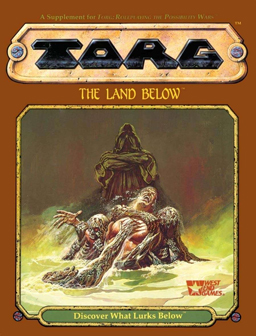 The old oracle, who named herself Krezmai, thanked Pel and named the beast she was fighting a ravagon, a hunter in the service of the Gaunt Man. Krezmai said that in exchange for the young elf’s help she would foresee for them.
The old oracle, who named herself Krezmai, thanked Pel and named the beast she was fighting a ravagon, a hunter in the service of the Gaunt Man. Krezmai said that in exchange for the young elf’s help she would foresee for them.
Having used the Paris scene to introduce gospog, the shock troops of the High Lords, I thought I could set up the ravagons here. So the opening adventure would present the players with, if not recurring adversaries, at least two of the more important types of enemies.
Breathing deep three times of the mists arising from the floor, Krezmai said:
“You are a hero, driven on the winds of the storm of high Possibility. There is much of your future I cannot see, for you are a free agent, more than most. But I will say that in the near now, death waits above; seek a future below. You must go on, longer than you imagine, through the abysms of lands you never could have known. You must not fear to pass through doors, though they will take you far; space and distance grow confused in these vaults below the earth. When you find your quarry you will find allies, among death and witchery. You must not hesitate to flee when wickedness grows confused, and to make your way out you must go further in. You will find a sixfold path awaits; in that place there are no wrong choices, though all lead to danger. Only I will tell you that to choose life is to choose a path that will take you most directly to your future — if you choose the way of the ice.”
Most of this prophecy refers to things the characters haven’t yet encountered, but as we’ll see, it’s got a number of hints in it. The Land Below is a tunnel network that developed as a side-effect of the invasion, underground tunnels curling through the crust of the Earth and through related dimensions, sometimes warping space in strange ways.
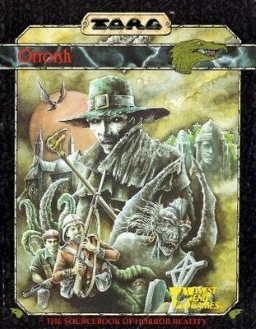 Pel followed the direction the oracle had pointed out for them. The walk was long, often through a narrow tunnel, sometimes along the side of a cliff that opened up into a vast deep dark lit by a miles-distant stream of lava. At last, after hours of walking along a path with no branching tunnels or side passages (though they felt, at times, as though there almost were tunnels, almost were other ways they might have gone, if they could have seen them to be confused by them), they came to a strange door. It was not of wood or stone but metal, and there was a metal box beside it with an ideogram of a door opening. Pel pushed on that image and the door slid open. Before them stretched a long passage, pure white, lit by the harsh unblinking light of high technology; and far along it, perhaps several hundred feet away, Pel saw what looked like human bodies. They walked along, and saw that past the bodies was a wooden door in one wall and a landfall blocking the end of the tunnel. They saw blood smeared everywhere, around the bodies, upon the white glowing panels of the walls — and they saw one of the humans move, slightly.
Pel followed the direction the oracle had pointed out for them. The walk was long, often through a narrow tunnel, sometimes along the side of a cliff that opened up into a vast deep dark lit by a miles-distant stream of lava. At last, after hours of walking along a path with no branching tunnels or side passages (though they felt, at times, as though there almost were tunnels, almost were other ways they might have gone, if they could have seen them to be confused by them), they came to a strange door. It was not of wood or stone but metal, and there was a metal box beside it with an ideogram of a door opening. Pel pushed on that image and the door slid open. Before them stretched a long passage, pure white, lit by the harsh unblinking light of high technology; and far along it, perhaps several hundred feet away, Pel saw what looked like human bodies. They walked along, and saw that past the bodies was a wooden door in one wall and a landfall blocking the end of the tunnel. They saw blood smeared everywhere, around the bodies, upon the white glowing panels of the walls — and they saw one of the humans move, slightly.
Pel hurried forward, and tried to do what they could for the human — but it was too late. The man, who was of the ethnicity the humans called Asian, laughed; and said he had destroyed the tunnel and killed the other men, but though he was dying, he had saved his daughter, and that was all that mattered. For a moment, as Pel tried to stanch his bleeding, he seemed to grow more coherent. He pointed at the wooden door, with its black wrought-iron latch: “Do you know what’s through there?” he asked. “Hell. Hell is through there. But when you find yourself in Hell — you keep going, deeper and deeper in, until … you come out the other side.” And with that he died.
Pel had walked into the realm of Pan-Pacifica, and my thinking was that they’d walked in on the very end of a dark Korean action film, with the bad guys dead and the hero dying and blood everywhere. The hero has a final enigmatic and symbolic line, dies, and that’s the end of the film — for him. As it happens, the symbolic final line had more direct meaning for Pel.
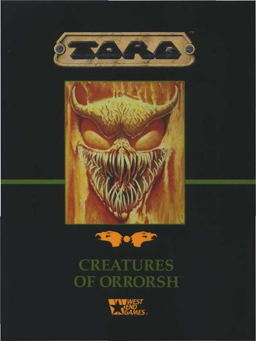 By instinct, Pel searched the bodies. They had no gold, only the strange slick cards the Earth folk valued. They ignored them, and, as one does, took their weapons to resell. Some of them had knives of an unnatural yet non-magical sharpness, and they set those aside for themself. The man who had spoken to them had a Siri of his own, and when Pel touched it it glowed with the still image of a girl; his daughter. They put it in their backpack as well.
By instinct, Pel searched the bodies. They had no gold, only the strange slick cards the Earth folk valued. They ignored them, and, as one does, took their weapons to resell. Some of them had knives of an unnatural yet non-magical sharpness, and they set those aside for themself. The man who had spoken to them had a Siri of his own, and when Pel touched it it glowed with the still image of a girl; his daughter. They put it in their backpack as well.
I have nothing particularly in mind regarding the dead man’s daughter. But if and when Pel finds themself in Pan-Pacifica, there’s now a plot thread ready to hand.
They faced the wooden door, beyond which lay hell. Carefully, they opened it a crack, and slipped through. Beyond was a vaulted stone room, built of heavy blocks, with low arches opening on to further darkness and the twittering of bats. Cobwebs and dust were everywhere. At the far side a set of stairs led up to another door. Before the stairs was a kind of dais, and on the dais was an elaborate black coffin. As Pel watched, the lid of the coffin began to move, as though something inside it were about to arise …
Pel raced through the room muttering “Nopenopenope,” past the coffin, up the stairs, and through the door.
This was as described by the player; they literally “nope”d their way through the room and up the stairs.
On the other side they wedged the door shut with one of the knives from the hall and a skull — for the halls of the narrow passage were lined with skulls and bones. From nearby, Pel heard the sounds they’d aready come to know as gunshots. Wandering to the end of the passage, where it joined in a T-shape with a much longer tunnel, a man ran into them. “Run!” he cried. “The knight’s after us!” Beyond him, Pel could see another man retreating before six of the plant-things they’d seen in the army’s camp. Beyond him …
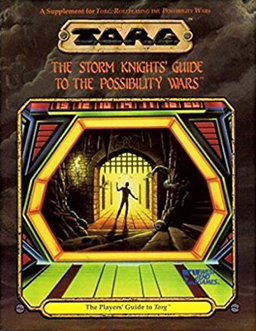 The cyberknight turned from Gaeira, realising his true object, Carl Sauvé, was getting away. Gaeira took the chance to shoot him. He staggered, then went down. Still moving at a magical speed, Gaeira ran down the hall, shooting one of the plant-zombies down as she came and running through the hole in the zombie formation that opened. She feinted toward the corridor that ended in the door through which Pel had emerged, so confusing the zombies chasing them and fooling them into investigating the hall. Then, running on, she caught up to Christian, then to Pel and Carl, and any of the zombies still after them were left well behind.
The cyberknight turned from Gaeira, realising his true object, Carl Sauvé, was getting away. Gaeira took the chance to shoot him. He staggered, then went down. Still moving at a magical speed, Gaeira ran down the hall, shooting one of the plant-zombies down as she came and running through the hole in the zombie formation that opened. She feinted toward the corridor that ended in the door through which Pel had emerged, so confusing the zombies chasing them and fooling them into investigating the hall. Then, running on, she caught up to Christian, then to Pel and Carl, and any of the zombies still after them were left well behind.
Only, they had all run so far and so fast, downward into the earth, none of them knew where they were …
And that was where we ended the session. The above represented a bit more than three hours of gameplay. Written out like this, it looks like events in the catacombs frame Pel’s story; in paractice, since the catacombs scenes involved a lot of dice-rolling, the opening sequence took up a goodly amount of time, while Pel’s journey, which was largely description and choices, was much quicker.
So on the one hand, I underestimated the learning curve for the rules. The game mechanics and card play were unfamiliar, and took a fair amount of explaining — particularly, I think, the idea that you rolled a die and matched what you rolled to a chart to get a bonus, rather than using the raw die roll. But then, on the other hand, as the game went on, things began to make more and more sense. By the end, the players were trading cards and explaining to each other how the numbers worked. So if the mechanics of the game are unusual, they’re also easily grasped with a bit of experience.
There was also something of a learning, or re-learning, curve on my end as well. Keeping track of modifiers and status conditions was tricky, though that was probably due to the rust that came from not running a game of any kind in several years. Comparing Torg Eternity with the original game, I found, as I’d expected, that the differences in the system tended in the direction of greater smoothness. It was easier for me in this iteration of Torg to tell my players what was happening mechanically, and point out options to them that the rules provided but that were not obvious.
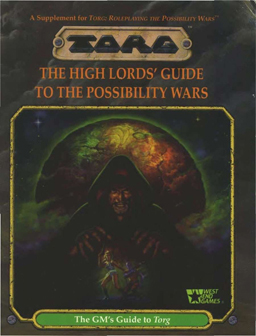 The players all told me they’d had fun, and said they saw the potential for storytelling in this system. One noted that the way the cards switched things up was a real benefit. Another observed that the system took getting used to, but was clearly very flexible. Another appreciated the fact that there was room for humour in the game, along with the action and violence. (Personally, I agree with that, and would say that the different registers in the game are one of its real strengths; events feel different in Aysle than they do in Orrorsh or the Cyberpapacy, high fantasy versus horror versus cyberpunk.)
The players all told me they’d had fun, and said they saw the potential for storytelling in this system. One noted that the way the cards switched things up was a real benefit. Another observed that the system took getting used to, but was clearly very flexible. Another appreciated the fact that there was room for humour in the game, along with the action and violence. (Personally, I agree with that, and would say that the different registers in the game are one of its real strengths; events feel different in Aysle than they do in Orrorsh or the Cyberpapacy, high fantasy versus horror versus cyberpunk.)
In the end, I thought the game felt like Torg. It felt like the rich, textured set of worlds that I remembered. The system brought out the setting very well, particularly through the use of the cosm cards, special cards that help reinforce the flavour of the realm the character’s in. Just by exchanging a player’s card for a new one I got across the idea that they’d crossed over to a new reality (when Pel went from Aysle to Pan-Pacifica to Orrorsh to the Core Earth hardpoint of Paris), and that their character was sensitive to the change. I’ll note that at no point in the game did anybody roll a 1, which would potentially have triggered the rules around “disconnection,” reality becoming aware of contradictory things happening. In relation to that, I note that Pel’s story didn’t involve very much dice rolling — there were a lot of choices made by the player, but ones that came from interacting with the setting. My point is that the game somewhat rewards staying out of combat, rewards not rolling dice, and conversely provides enough richness in its ideas that the characters can interact with the world around them by means other than violence. But the violence, when it happens, is ably supported and appropriately exciting.
Torg Eternity captures what made the original Torg work, giving room for all the concepts and strangeness of the original while reining in the complexity of the rule systems and subsystems. It moves smoothly, supporting cinematic action in a range of tones. I think it helps in running the game to know some of what was done in the original system, but as time passes and the new game provides more sourcebooks and options, that’ll be less and less true. And in any event the game’s openness is a virtue, a setting that provides eight worlds to explore and eight genres to play with in any combination the gamemaster and players wish. It’s suprising, sometimes, how deeply a story can hook into one’s soul; I hadn’t realised how much I’d missed Torg. I’m glad it’s back, and better than ever.
Matthew David Surridge is the author of “The Word of Azrael,” from Black Gate 14. You can buy his first collection of essays, looking at some fantasy novels of the twenty-first century, here. His second collection, looking at some fantasy from the twentieth century, is here. You can find him on Facebook, or follow his Twitter account, Fell_Gard.